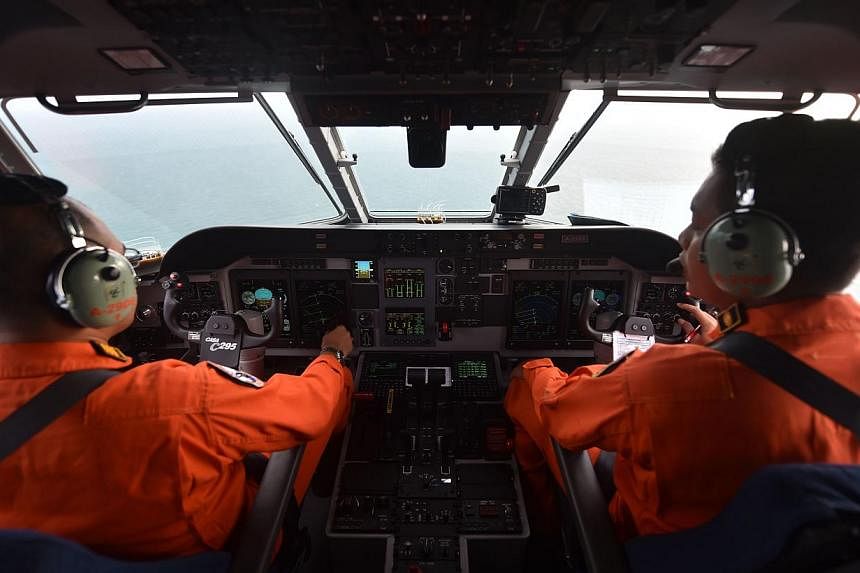Search teams will focus on looking for the black box flight recorders of AirAsia Indonesia flight QZ8501, now that debris and bodies have been found in the Karimata Strait off the coast of Borneo.
The recorders, which store cockpit communication and sounds from the front of the plane as well as key data points, will shed light on the final moments of the plane which went down in the Java Sea with 162 people on board during its journey from Surabaya to Singapore on Dec 28.
Experts expect the black box to be located within two or three days, given the shallow waters of the Java Sea, which has an average depth of about 46 metres, reported Washington Post. At those depths, divers can be used along with receivers to listen for the recorders' acoustic transmitter that sends out a unique clicking sound.
Here are seven things about the black box:
1. What is inside the black box?
The black box is made up of a flight-data recorder and a cockpit-voice recorder.
The flight data recorder is an independent device that preserves the recent history of the flight, through the recording of dozens of parameters, collected several times per second.
The cockpit voice recorder preserves the recent history of the sounds in the cockpit, including the conversation of the pilots.
2. Black box is, in fact, orange
Even though it is called a "black box", it is usually painted bright orange so that it is easy to spot.
It is waterproof and designed to withstand 3,400 times the force of gravity on impact, meaning it is highly likely that it can withstand any breakup of the plane, reported Bloomberg News.
3. Where is the black box located?
It is usually installed in the tail of the plane which is subject to the least impact in the event of a crash. The exact location a black box is installed depends on the individual plane. Possible spots include the ceiling of the galley, in the aft cargo hold or in the tail cone that covers the rear of the aircraft.
4. How do search teams locate the black box?
The flight recorders have emergency beacons that emit pinging noises. Investigators need to be nearby to pick up the "pings".
The recorders would usually start sending signals once they are submerged, with the pinging lasting for 30 days until independent power supplies run out. Sometimes, they last for eight to 10 days beyond that.
Search teams can use underwater microphones to help find the black box. According to Bloomberg News, units made by Honeywell emit signals that can be heard from 2.8 miles (4,506 metres) deep.
5. How long does it take to find the black box?
In some cases, the search can take months or even years.
When Air France Flight 447 with 228 people on board went missing in 2009 while it was flying over a large body of deep water, search-and-rescue operations found debris and some of the bodies in the weeks following the crash. But it took almost two years to find the main wreckage and the black boxes, deep in the middle of the Atlantic Ocean.
Search teams have yet to locate the wreckage and black box of Malaysia Airlines MH370, which disappeared on March 8 this year while flying from Kuala Lumpur to Beijing.
6. What happens after the black box is retrieved?
Investigators will have to analyse the recordings, a process that will likely take two or three days, said Washington Post.
Only a handful of countries have the technology to do it, including the United States, Canada, Australia, Britain and France, the Post reported, quoting former pilot and accident investigator John Cox, who is now chief executive of the Washington-based consulting firm Safety Operating Systems.
7. Are there other ways to record flight information other than using the black box?
The aviation accidents this year have rekindled a debate about whether black box flight recorders should be replaced with satellite-based systems capable of sending back telemetry in real time.
Such systems exist. According to The Wall Street Journal, a few hundred airplanes around the world have already been outfitted to stream live data via satellite.
But not many carriers have equipped their aircraft with this because of the rarity of in-flight disasters, and the high cost involved in upgrading equipment and putting in more satellite connections.
Sending all the data from each flight in real time via satellite would be extremely costly. According to Bloomberg Businessweek, a 2002 study by L-3 Aviation Recorders and a satellite provider found that a US airline flying a global network would need to spend US$300 million (S$396 million) per year to transmit all its flight data, even assuming a 50 per cent reduction in future satellite transmission costs.
Source: Washington Post, Reuters, AFP, Bloomberg News




